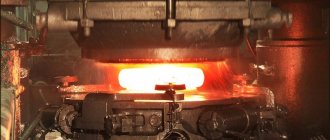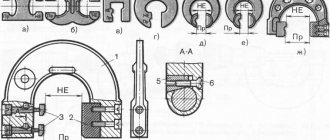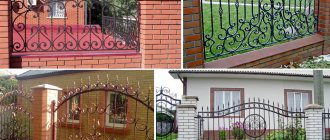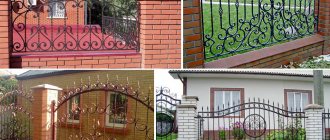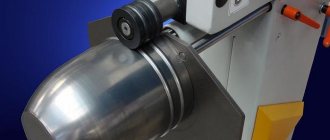To view the video, you need a modern browser that supports HTML5 video.
The invention of the sheet was a real breakthrough in metalworking. And almost immediately, having assessed the plastic properties of the resulting product, the craftsmen began to think that it could be given different shapes. The first example of cold metal stamping was the simplest embossing: a sheet was placed on a mold made of wood, and then systematically tapped with a hammer.
The technology was complex and labor-intensive. But hundreds of years had to pass before the invention of mechanisms that would make work easier...
Features of cold stamping of sheet metal parts
The “first sign” of serial stamping technology arrived in metalworking shops in the mid-19th century.
It was then that the first machine tools were invented and put into operation. But stamping reached a truly outstanding scale with the advent of the automobile industry, and in the 30s of the last century - aircraft and rocket manufacturing. The production of parts using the cold stamping method began to be used for the production of housings and internal components. Technology has developed rapidly and, perhaps, even now has not reached its peak in everything. Modern stamping without heating to high temperatures is capable of creating parts of any shape and size - as a finished product or “semi-finished products” for subsequent processing. The manufactured products are distinguished by precision and increased strength.
Cold metal stamping: technology
In the stamping process, the most important role is played by the preparatory stage—the production of tooling.
It is produced in the workshop, but originates in the design bureau, where technologists and designers are involved in the process. They evaluate what final shape the product should achieve, how many stamping operations should take place and in what sequence. The result of the collaboration of these specialists is the creation of a matrix-punch pair. Next, the project goes to the workshop, where cold metal stamping occurs: under the influence of pressure, the matrix and punch stamp the required number of parts from sheets or strips. Cold stamping is called such with some convention: after obtaining impressions of the desired shape, in order to strengthen them, a final heat treatment can be carried out - recrystallization annealing.
Sometimes the stamping operation can be supplemented by simultaneous punching or drawing. For this purpose, an insert made of particularly hard metals or alloys is added to the matrix and punch. But the possibility of such work must be calculated at the design stage.
Initial data for design
Table 1.1 - Number of parts manufactured for one machine kit
| product name | Number of items per product, pcs. | Number of manufactured parts per product, pcs. | Weight per product | |
| Source materials, kg | Finished parts, kg | |||
| ZIM-350 | 160 | 250 | 63 | 45 |
Table 1.2 - Number of parts manufactured for the annual program
| Name products | Unit | Quantity per annual program | Number of parts per annual program | Number of parts per annual program | Weight for the annual program | |
| Source metal, t | Finished parts, t | |||||
| ZIM-350 | PC. | 250000 | 160 | 250 | 15750 | 11250 |
Cold stamping of parts in Moscow
The demand for cold stamping services in the capital has remained quite unstable over the past 30 years. Unexpected declines in the number of orders, usually associated with economic crises, are followed by equally unexpected periods of recovery. There is no doubt about one thing: Moscow stamped steel is sold to metropolitan enterprises in hundreds of thousands of tons. Customers are attracted by:
- high accuracy of product dimensions;
- elimination of surface defects;
- Compared to “hot” technology, there are no traces of heat treatment, such as scale.
Working using cold metal stamping technology is also beneficial for the performers, since it is less labor-intensive and more productive. Finally, both customers and contractors note the fact that this production method uses less material.
Types and methods of modern metal processing
Cold stamping, along with hot stamping, is considered one of the oldest technologies for processing sheet blanks.
Along with them, modern production can use more advanced, but at the same time expensive ones. For materials with high plasticity, hard rubber stamping is used. Its disadvantage is that it is impossible to process a large series of rolled products in this way. Also interesting is the technique in which metal changes shape due to liquid pressure. In this process, a liquid substance acts as a punch, pressing the sheet tightly against the die. This technology is used if it is necessary to obtain products of complex shapes.
Blast wave stamping is considered quite “aggressive”, but effective. As a result of the mini-explosion, the material is pressed into the matrix.
The choice of method is determined by the complexity of the final part, as well as its size.
Drawing
Sheet stamping - a method of manufacturing flat and three-dimensional thin-walled products from sheet material, tape or strip using stamps on presses or without the use of presses. Sheet stamping is divided into hot and cold.Hot stamping. It is mainly used in the production of boiler bottoms, hemispheres, buoys and other hull parts for shipbuilding. They are made from steel sheet with a thickness of 3 ... 4 mm. Hot sheet metal stamping operations are similar to cold stamping operations. However, when designing a technological process, heating is always taken into account. When drawing up a drawing of a workpiece, it is necessary to take into account the shrinkage of the metal during cutting, punching and bending, as well as the degree of warping when the part cools, since its dimensions are somewhat reduced. This circumstance forces us to increase dimensional tolerances in comparison with cold stamping. Workpieces are heated in flame and electric furnaces, as well as in electric heating devices.
Cold stamping . This is the most progressive method of pressure processing, since it allows you to obtain parts that in most cases do not require further cutting. Cold sheet stamping is used to produce both large and small parts (car frames and bodies, aircraft chassis, ship trim elements, watch mechanism parts, etc.).
Sheet stamping allows for greater savings in metal usage while at the same time providing high productivity. But it gives the greatest effect in mass and large-scale production.
Cold sheet stamping uses carbon and alloy steel, aluminum and its alloys, copper and its alloys, as well as non-metallic materials: cardboard, hard rubber, leather, rubber, fiber, plastic, supplied in the form of sheets, tapes and strips.
Sheet stamping technology. The main technological equipment for the manufacture of products by sheet stamping are vibrating shears (Fig. 77), crank presses (see Fig. 87 and Fig. 88) and hydraulic presses. Sheet stamping operations can be divided into two main types: parting and forming. The main separating operations include: cutting, punching and punching.
Rice. 77
Rice. 87
Rice. 88
Cutting is an operation where sequential separation of part of the workpiece occurs along a straight or curved line. Cutting is used to obtain both finished parts and cutting the sheet into strips of the required width. When cutting a sheet, it is necessary that the output of parts from the sheet is maximum and waste is minimal. The rationality of cutting is determined based on the calculation of the material utilization rate. The coefficient is understood as the ratio of the area of the cut parts to the area of the sheet. The cutting operation is carried out using vibrating, disk, guillotine and other shears.
Vibrating shears (Fig. 77) are a machine with short knives. The upper knife 5 receives oscillatory movements from the electric motor 1 through an eccentric mechanism. The sheet metal is installed on the table 7 and moved between the upper 5 and lower 6 knives until it stops 3, which can be moved and secured in the frame bracket, 2.4 - the head, 8 - the bed stand.
Cutting is an operation to obtain a closed-loop blank (Fig. 78). In Fig. 79 shows drawing (I) and diagram (II) of a typical part made from strip by cutting.
Rice. 78
Rice. 79
Punching - making holes in a part of the desired shape (Fig. 80).
Rice. 80
The main forming operations* include bending, drawing, flanging, crimping and forming.
Bending is an operation in which a flat workpiece is given a curved shape (Fig. 81: 1 - punch; 2 - neutral layer; 3 - matrix): R and r - outer and inner bending radii, S - thickness of the material. It can be V-shaped, U-shaped, etc. (Fig. 82).
Rice. 81
Rice. 82
In Fig. 83 shows a drawing of a part in which the holes are made by punching. After this, the part is bent on the die.
Rice. 83
Drawing is an operation that turns a flat workpiece into a hollow spatial part or semi-finished product 2 (Fig. 84). The hood is used to produce not only cylindrical parts, but also complex-shaped box-shaped, conical and hemispherical ones. When drawing, the flat workpiece 5 is pulled by the punch 1 into the hole of the matrix 3. To prevent the formation of folds in the workpiece under compressive stress, clamps 4 are used.
Rice. 84
The hood can be without thinning or with thinning. In the first case, it occurs without a noticeable change, in the second, not only the shape of the workpiece changes, but also the thickness of its walls. In the case when it is necessary to obtain a deep drawing, it is carried out in several passes. In Fig. 85 shows a drawing of a typical part made from metal sheet 1, made by stamping with drawing.
Rice. 85
Beading is the operation of forming edges along the outer contour of a sheet blank or around pre-punched holes (Fig. 86). It is used mainly for the formation of necks in flat parts 2, necessary both for threading and welding or assembly. Usually it is performed sequentially (I, II, III) in one or several passes in dies consisting of punch 1 and matrix 3. The flanging operation is very often performed at the ends of pipes when connecting flanges to them, with the help of which the pipes will be connected in the future.
Rice. 86
Crimping is an operation of narrowing (reducing) the end part of hollow or three-dimensional parts. It is carried out by compressing the material with a stamp from the outside in a conical matrix. In this case, the configuration of the crimped part depends entirely on the shape of the die.
Molding is an operation associated with a local change in shape while maintaining the configuration of the outer contour of the part. An example of molding is the production of stiffeners on engineering parts, as well as an increase in the diameter of the middle part of a hollow part.
The technological process of processing various materials by pressure, as mentioned above, is carried out on presses. Presses are hydraulic and mechanical (crank, screw, rack and pinion, etc.). According to their purpose, presses are divided into forging, stamping, sheet-stamping, embossing, trimming, pipe-shaping, bending, straightening, briquetting (for the production of briquettes from lumpy or powdery materials), forging and stamping machines, thermoplastic machines, etc.
Crank hot stamping presses GOST 6809-87E (Fig. 87) are manufactured in Russia with pressures from 61.78 to 617.8 kN (mc is a unit of force and weight). They consist of a frame 1, a slider 2, a connecting rod 3, a crank shaft 4, 5 service columns, a gear 6 and a friction clutch 7. The use of presses for hot die forging is very effective in comparison with other technological equipment. They provide higher precision forgings with significant metal savings. The presence of induction electric heating in them helps to improve working conditions in the workshop: noise and shaking of the building are reduced, and smoke in production premises is eliminated. The press is controlled by regulatory bodies and with the help of compressed air from the workshop line.
Rice. 87
In Fig. Figure 88 shows a press for cold stamping GOST 9408-89E, consisting of a rack 1, an electric motor 2, a slider balancing cylinder 3, a gear 4, guides 5, a slider 6 and a press table 7. Both small and large sheet parts are produced on such presses , for example, car bodies. Possible press pressure is 30.89 kN.
Rice. 88
Hydraulic presses have the best characteristics for deep drawing and other sheet metal stamping operations, since they deform the metal at a constant speed. Such presses are widely used in the aviation and rocket industries.
In Fig. 89 and 90 show large aircraft assembly units, the parts of which are made by pressing. Thus, the floor frame of an aircraft passenger cabin (Fig. 89) includes: skin 1, frame 2, stringers 3, transverse beams 4 and continuous beams 5. And the nacelle of an aircraft turboprop engine (Fig. 90) consists of a propeller hub fairing - 1 , air intake 2, front hood cover 3, rear hood cover 4, hatch 5, power truss, casing 7, stacker 8, tail part of the nacelle 9, power frame 10, oil cooler frame 11, power frame 12 and side beam 13.
Rice. 89
Rice. 90
Progressive methods of cold sheet stamping. New types of stamping, due to their simplicity and efficiency, are widely used in small-scale and single-piece production. These include stamping with rubber, liquid, explosion, electro-hydraulic, etc.
Rubber stamping . With its help, separation and form-changing operations are carried out. In this case, the punch or matrix is rubber. Rubber stamping is most often used for products made of thin sheet metal up to 2 mm thick (aluminum, copper alloys, low-carbon steel).
Liquid stamping. In this case, the metal is deformed under fluid pressure, taking the form of a matrix. This method is used for drawing hollow parts of various shapes.
Explosion stamping . To plastically change the shape of a workpiece, explosives are also used (explosive gas mixtures of methane, propane, hydroxygen, etc.), creating high pressure, under the influence of which the workpiece takes the shape of a stamp.
Explosion stamping is used for the manufacture of large parts and parts of complex shapes, when their manufacture by other methods is impossible (for example, hard-to-deform alloys) or uneconomical. Such
stamping does not require complex and expensive equipment.
Electrohydraulic stamping . This method is characterized by the fact that the energy carrier is a high-voltage electric charge in the liquid. The discharge causes the appearance of a shock wave, which deforms the workpiece, giving it the required shape.
This type of stamping makes it possible to perform all cold sheet stamping operations with great accuracy and at relatively low cost.
Magnetic pulse molding. The formation of products by this method occurs when a pulsed magnetic field is created around the workpiece and the interaction of this field with pulsed currents flowing in the workpiece. As a result of this interaction, eddy currents are excited in the workpiece, which also leads to the formation of an electromagnetic field around it. This creates the prerequisites for a dynamic effect on the workpiece and its deformation.
This method is used to perform compression of pipe blanks, relief molding, cutting, etc.
There are other progressive methods of sheet stamping, but we will not consider them.
* Shaping operations are those by which spatially shaped parts are obtained from a flat workpiece
Cold sheet stamping is a guarantee of high-precision parts
Despite its apparent archaic nature, the production of parts using the cold stamping method has no equal in demand. Customers are attracted by:
- impeccable accuracy of the obtained impressions,
- high process automation,
- low costs for the production process,
- little waste,
- completeness.
In fact, the most difficult stage of the work is not the production of a part that can be produced quickly and in any quantity, but the design.
Areas of use
The method is in demand in various industries where it is necessary to give metals a given shape. The production of parts using stamping is used in the following areas:
- automotive industry;
- production of electronics, watches, etc.;
- construction;
- printing;
- mechanical engineering;
- aircraft manufacturing, etc.
Thanks to high-tech devices during the processing process, it is possible to obtain workpieces of a given shape of different sizes with a minimum of waste.
Materials used in cold metal stamping
Stamping operations are possible on all metals and alloys that have sufficient ductility.
But parts made from them may have a limited scope of use. Simple carbon steels are suitable for the production of manufactured goods and products that do not need to withstand heavy loads. Alloyed structural steels withstand not only stamping, but also operations combined with welding. Stamped aluminum blanks are in demand in the assembly of equipment and instrument making, copper - in electronics, nickel-plated - in the production of tableware and jewelry.
Die steels
X12MF grade steel is one of the most sought-after and popular malleable alloys, which have undergone an enrichment procedure with special chemical elements (alloying impurities) in order to acquire improved mechanical and physical properties.
The brand belongs to the category of tool alloyed stamped metal grades.
Steel grade 5ХНМ, as well as metal grades that replace it, are supplied to the market in the form.
Tool die steel 4Х5В2ФС. It is used in mechanical engineering, for the manufacture of molds and various workpieces.
Steel 7ХГ2ВМФ for stamping, tooling. The alloy is used to make cutting tools and products for various purposes.
Steel 3Х2В8Ф stamping tool. A heat-resistant alloy is characterized by hardness and the ability to work at high heating temperatures.
Steel 7Х3 stamping, tool. Fasteners, dies, punches and other products are manufactured.
Kh12MF-Sh steel has high density and resistance to impact loads.
The composition of steel includes (11-12%) chromium; (1.45?1.65%) carbon; (0.4?0.6%) molybdenum; (0.15?0.3%) vanadium
4Kh5MFS tool steel is widely used in mechanical engineering. There is increased viscosity and heat resistance achieved by alloying additives.
4Х3ВМФ tool stamping steel is used for the manufacture of dies, stamping tools, and in mechanical engineering.
Steel 7Х3 belongs to the tool class.
Die tool steel grade X12M is widely used in the metalworking industry.
Tool die steel 4ХВ2С is used for the manufacture of parts operating under high shock loads. Trimming dies, chisels, crimps.
Steel 6ХВ2С tool stamping. It has the ability to withstand severe loads and is resistant to deformation processes.
Tool die steel 5ХВ2С is used for the manufacture of parts operating under increased shock loads - dies of complex configurations, crimping dies/punches for cold work, thread-rolling dies, knives for cold cutting of metal.
Application: for heavily loaded pressing tools (small inserts of the final die strand, small insert marks, dies and punches for extrusion, etc.) during hot deformation of alloyed structural steels and heat-resistant alloys.
Tool die steel 6ХВГ is used for punching shaped holes (mainly) in strip/sheet material - punches of complex configuration; to minimize changes in the dimensions of the part during hardening, use small hot stamping dies.
Tool die steel 6ХС is used for the manufacture of small cold stamping dies, pneumatic chisels, and chipping knives.
Stamped tool steel is widely used for the production of various tools that are used in the processing industry. These tools are used to process metal workpieces under pressure. Thus, stamped steel is used in the manufacture of punches, dies, rollers, rollers and other processing devices. It is from stamping devices that the name of this type of steel comes from.
Cold and hot sheet metal stamping
Hot sheet stamping also accounts for a significant share of the metalworking market. In contrast to cold metal stamping:
- there is less risk of workpiece destruction;
- deformation does not require much effort, and therefore not much equipment power;
- the processed material can acquire a granular structure, and with it increased strength.
But this technique also has disadvantages, and significant ones:
- much higher production costs;
- less accuracy, including due to temperature fluctuations;
- scale formed on the surface of a metal.
- deterioration of some mechanical characteristics of the material.
Types of sheet metal stamping equipment
The mechanical process of manufacturing parts by stamping is quite simple, but it can be produced on machines of different types and classes.
Let's consider the types of pressing equipment for stamping operations. Crank presses
named after the type of drive. They are considered the simplest in the line of machines for this purpose. With their help, you can process sheets with a small cross-section and produce parts of very modest sizes.
Compared to this technique, hydraulic presses
much more powerful. Just imagine: they can exert pressure equal to two thousand tons on the workpiece! In addition to the potential, the advantages of these machines are considered to be greater control over the controls and more accurate debugging. If you need to turn sheets of considerable thickness into parts, a crank press will be useless, but a hydraulic one will do the job.
Radial forging presses have a more specific application.
. They are used to produce products with the shape of a body of revolution.
Electromagnetic presses are considered the latest invention in the machine tool industry.
, which operate on the basis of an electromagnetic field. The key “tools” of the process are the core and the punch, which interact based on electromagnetic pulses. The technique is quite effective, and yet electromagnetic equipment is inferior to hydraulic equipment in power.
Technology for stamping parts from metal sheets
Pressing equipment uses pressure force, but the operations based on this force vary significantly depending on the type of workpiece. Extrusion technology is used to produce rod-shaped parts. In the production of hardware products - studs, screws, bolts, etc. - the cold heading technique is used. Sheet blanks are processed using the molding method described above, which guarantees the production of three-dimensional products.
Cold die stamping of sheets to order
Do you have sheet metal and ideas about what it should be transformed into? We are ready to take on your project in the coming days and complete it turnkey - from creating drawings and developing equipment to the actual cold stamping of metal. Modern technologies and equipment allow us to process workpieces from any materials:
- gland,
- become,
- aluminum,
- copper,
- titanium and others.
During the production cycle, we will carry out all the necessary operations on your rolled products: cutting, bending, drawing, forming, crimping and others. Additional advantages of working with us are low prices, the ability to order stamping at a discount and always high quality work.
Process technology
Each technological process involves carrying out certain operations. In this case, they are associated with the formation of sheet metal using cold steel, which is performed on appropriate equipment. It is based on:
- Initially, the essence of the operation, its fundamental processes, which will have to be performed in the appropriate sequence, are indicated.
- Drawing up a sketch.
- The next step is to calculate all dimensions at the stage of procurement, formation and finished product.
- The location of all necessary holes, recesses and other elements required by the corresponding part is indicated.
- It is imperative to document all stages of the process by entering data with dimensions.
- After approval of the drawings, the products are manufactured.
But it is also possible to make changes using additional operations, which contribute to its convenient processing. This may include straightening sheet material, applying lubricant, or other operations that will be required during stamping.
The information provided gives a complete picture of the chemical process itself, which is carried out on appropriate equipment using special materials. In addition, thanks to the introduced innovations, the technology used makes it possible to manufacture high-quality products on an industrial scale. And also reducing the amount of waste material, which in turn makes such production very economical.
Republished by Blog Post Promoter


